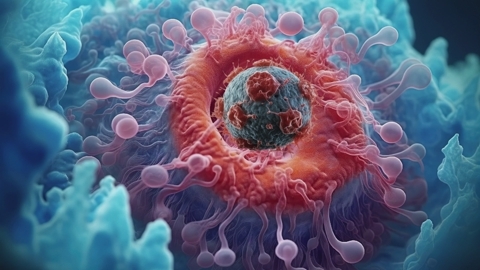When harmful radiation targets a cancer cell a few millimeters in size, healthy tissue is also affected. Christian Pottmeyer experienced this firsthand.
When harmful radiation targets a cancer cell a few millimeters in size, healthy tissue is also affected. Christian Pottmeyer experienced this firsthand.
The rays can cause cancer patients serious side effects and long-term damage.
Christian Pottmeyer was in top shape but noticed something was wrong. One morning, he felt a small lump on one of his testicles.
Two days after being sent for a checkup at Bærum Hospital, he was on the operating table.
After ten radiation treatments, my body was drained of energy, says the father of three.
"After ten radiation treatments, my body was drained of energy, says the father of three."
"After ten radiation treatments, my body was drained of energy, says the father of three."
When cancer is targeted for destruction
After surgery, Christian Pottmeyer was down one testicle, and ahead of him waited a long year of radiation and chemotherapy. The cancer had spread to the other testicle.
Now, industry-developed technology and artificial intelligence can revolutionize radiation therapy with unprecedented precision.
"It felt completely unreal, as if it wasn't happening to me," he says.
It took over two years of extreme fatigue, weakness, and severely reduced appetite. He still hasn't returned to the shape he was in when training CrossFit five days a week and working full-time in a demanding job.
Journalist: Björn Audunn Blöndal
Photo/video: Björn Audunn Blöndal, Element Envato, Varian Medical Systems, Alamy
A Different Kind of Exhaustion
"This is a different kind of exhaustion than one experiences as a healthy person. People struggle to understand this. You can still push through with a hard workout when you're healthy and tired after a long day of work. After cancer and radiation treatment, there's nothing. The body can't handle anything, he emphasizes.
Section leader Karsten Rydén-Eilertsen at Oslo University Hospital explains:
"This is what we call fatigue, and it's a widespread side effect of radiation therapy," he says.
Furthermore, the patient may experience a range of other side effects, both severe and less serious.
"We don't administer radiation doses to patients that we believe could cause death from the radiation treatment. However, very rarely, this can happen - entirely unintentionally - because an organ in a specific patient may respond differently to radiation than expected," he elaborates.
"In the extreme consequence, radiation can be life-threatening."
A malignant cancer tumor can be so large that it spans several centimeters, but it can also be just a few millimeters. That's precisely why it can be very difficult to detect. And no less challenging is hitting it with harmful radiation while minimizing damage to the healthy tissue around it.
"To reduce the risk of these severe side effects, we need to figure out how to target the tumor more accurately - while also reducing the radiation exposure to healthy tissue," Rydén-Eilertsen explains.
"And we must understand how the patient's anatomy changes over time."

Karsten Rydén-Eilertsen
SECTION LEADER, OSLO UNIVERSITY HOSPITAL

Of course, we can 'see' inside a person today. We've had technologies like X-ray and CT scans for years. The challenge is that we can't observe internal organs in real time. However, using a technological method we call digital twinning is possible.
Traditionally, digital twins are used to observe environments where it's impossible or extremely costly to see directly. For example, in space, at ocean depths, or inside advanced industrial machinery. This methodology is employed in several areas within the Kongsberg Gruppen.
"By applying this technology in new domains, from healthcare to smart cities, we're not only able to solve today's challenges more effectively but also to shape the future with innovative solutions that can potentially improve people's lives worldwide," she says.
"In every part of the Kongsberg Gruppen, there is constantly an immense amount of knowledge and experience being built, not least through the use of digital twinning, she adds. Sometimes, knowledge created within the Kongsberg Gruppen is taken out into new entrepreneurial ventures and flourishes within entirely different societal sectors."
"We're working with world-class advanced engineering. We're at the forefront in several areas we work in," says Hauan Strand.
"In short, a digital twin is a digital representation of a physical object."
Jannicke Hauan Strand
Director of Communication, Kongsberg Digital
Looking Inside a Body


One of these startup companies created on the periphery of the Kongsberg Gruppen is Kongsberg Beam Technology. The company is precisely working on transferring the methodology of digital twinning to medicine.
This advanced technology makes the impossible possible: seeing inside the human body in real-time. More on this later.
The technology is so groundbreaking that Radiumhospitalet (Oslo University Hospital) and Oslo Cancer Cluster have collaborated with Kongsberg Beam Technology to make future radiation therapy as gentle as possible. The company has also received support from Innovasjon Norge (Innovation Norway) and Forskningsrådet (the Research Council of Norway.)
From Industry to Medicine




So, every day over many weeks, one must target a small tumor of just a few millimeters deep inside a body based on an image formed about 10 days before the treatment began.
The cancer may also be close to or inside critical organs such as the heart, lungs, brain, or testicles. The distance between the original image and the patient's condition gradually increases as the treatment extends over several weeks.
First, a bit about how radiation therapy is conducted today:
About ten days before radiation treatment begins, a CT scan of the patient's body is performed. With the scan as a basis, a treatment plan is developed. A doctor first determines the extent of the cancerous tumor and the radiation dose to be used.
Subsequently, radiation therapists and medical physicists create a dose plan that describes, among other things, how to adjust the radiation machine, such as the angle, size, and strength of the beam.
Creating the treatment plan typically takes about one week. The patient can begin radiation therapy once the plan is reviewed and approved. To effectively target a malignant tumor while avoiding excessive side effects, the treatment is often administered in the form of many smaller radiation doses over several days.
Radiation therapy for testicular cancer is typically divided into approximately 15 treatments, while for head and neck cancer, as many as 35 treatments may be necessary. This variation is due to differences in the sensitivity of the cancer tumors to radiation.
"Many factors can affect the position of the cancer tumor inside the body. The patients' physique, how much they've eaten, and their positions on the treatment table. Mainly how the cancer tumor develops throughout the treatment process and how it responds to treatment.
Even the patient's breathing and heartbeat will continuously cause movements in the tumor," explains Rydén-Eilertsen.
Digital Twin
"We can't see inside the patient during the actual treatment. Therefore, we also can't hit the target precisely. We know we can't do that," says Per Håvard Kleven, founder and CEO of Kongsberg Beam Technology.
This is the problem Kleven wants to solve.
In the absence of direct insight into the human body, Kleven and Kongsberg Beam Technology have devised an almost as a good solution: creating an identical digital twin of the entire patient, both on the outside and inside, and then updating it in real-time with a wide range of different data sources.
"In the digital replica, we can see everything. We can focus closely on the tumor but also on the heart, lungs, and other critical organs. That way, we can see how everything moves and where the tumor is positioned at any given time," he explains.
"Or at least 20 times per second, he adds. With every heartbeat and every breath, the digital twin is updated. We need to be absolutely sure that when the patient's heart beats, the movements are completely identical in the digital replica." At all times, he says.
Kongsberg Beam Technology also utilizes machine learning to predict how the patient's body changes during the treatment plan.
"Seeing" the unseen surroundings is not a new challenge for Kleven. After a long career at Kongsberg Gruppen, he founded Devotek, which provided engineering services to the aforementioned group.
"At Devotek, we worked with very advanced control systems. These are systems where both mechanics, electronics, and software are involved. We often dealt with safety-critical matters, often with things in motion, things we couldn't see - and especially things that could be very costly if they failed," he adds.
"We provided technology to fields such as aviation, maritime, defense, aerospace, automotive, oil, and gas. Delivering to so many different segments gave us a unique opportunity to transfer knowledge from one area to another," he says.
Machine Learning on the Body
Kongsberg Beam Technology also utilizes machine learning to predict how the patient's body changes during the treatment plan.
"Seeing" the unseen surroundings is not a new challenge for Kleven. After a long career at Kongsberg Gruppen, he founded Devotek, which provided engineering services to the aforementioned group.
"At Devotek, we worked with very advanced control systems. These are systems where both mechanics, electronics, and software are involved. We often dealt with safety-critical matters, often with things in motion, things we couldn't see - and especially things that could be very costly if they failed," he adds.
"We provided technology to fields such as aviation, maritime, defense, aerospace, automotive, oil, and gas. Delivering to so many different segments gave us a unique opportunity to transfer knowledge from one area to another," he says.
Machine Learning on the Body
"Working with digital twins is a scientific methodology that we have been working on for many, many years at Kongsberg Gruppen," says Kleven. Digital twins are essential when working with high precision in environments that cannot be seen in real-time.
Now, Kleven is bringing this mindset into medicine.
"Millions of people worldwide are diagnosed with cancer every single year. In Norway, about thirty thousand people receive this life-changing diagnosis. Over half of them will benefit from radiation therapy," he explains.
"Radiation causes many side effects, which is a significant issue in cancer treatment. During radiation therapy, healthy tissue inevitably sustains damage, ranging from minor effects like fatigue, nausea, and loss of appetite to very severe side effects," explains Kleven. When the rays hit critical organs, they can experience reduced function or, in the worst-case scenario, cease to function altogether.
"This significant problem is being tackled by thousands of researchers, engineers, doctors, and system operators worldwide. But we haven't seen anyone who's trying to eliminate it. Several try to compensate for it, but no one is trying to solve the fundamental problem. To find a proper solution, we must be able to 'see' inside a person in real-time. That cannot be done today. It's impossible," he says.
"The closest technology has come is the use of MRI integrated into X-ray machines, referred to as MR-Linac," Kleven explains. He adds that, in his opinion, this is not accurate real-time imaging.
– Å jobbe med digitale tvillinger er et vitenskapelig metodeverk som vi har jobbet med i mange, mange år i Kongsberg Gruppen, forteller Kleven. Digitale tvillinger er helt nødvendig når man jobber med høy presisjon i miljøer man ikke kan se i realtid.
Nå tar Kleven med seg dette tankegodset inn i medisinen.
– Millioner av mennesker verden over får kreft hvert eneste år. I Norge er det noen og tredve tusen som får den dystre diagnosen. Over halvparten av de vil ha nytte av strålebehandling, forteller han.
– Det er et stort problem med kreftbehandling, og det er skadene som uunngåelig blir påført friskt vev. Stråling gir mye bivirkninger. Alt fra mindre alvorlige – som tretthet, kvalme og tap av appetitt – til svært alvorlige og livsødeleggende bivirkninger, forteller Kleven. Når strålene treffer kritiske organer, kan organene få redusert funksjon. Eller i verste fall slutte helt å virke.
– Og dette store problemet er det tusenvis av forskere, ingeniører, leger og systemoperatører over hele verden som prøver å løse. Vi har ikke sett noen som egentlig prøver å eliminere det. Det er flere som kompenserer for det, men ingen prøver å løse basisproblemet. For å løse det helt, må vi kunne “se” inn i et menneske – i sanntid. Det kan man rett og slett ikke i dag. Det er umulig, sier han.
– Det nærmeste teknologien er kommet er bruk av MR innebygget i røntgenstråle-maskiner som benevnes av MR-Linac, forteller Kleven. Han legger til at dette ikke er ekte sanntid etter hans mening.
From Rays to Protons
Over the next two years, an entirely new form of radiation therapy will be established at Radiumhospitalet (Oslo University Hospital) and The Hospital in Bergen. They are both setting up centers for proton therapy. In short, this means that the apparatus emits particles instead of photons, which are high-energy waves.
"In this context, it is even more critical that we know what the patient looks like," Rydén-Eilertsen explains.
"The treatment we provide today is not sensitive to what kind of tissue the dose deposits. Protons are."
This means that the range of protons will be affected by whether they pass through, for example, soft organs, fat, or hard bones. Another aspect is that protons deposit their energy when they stop. At that time, they damage the tissue, ideally targeting the cancerous tumor as much as possible. Some protons will hit before the tumor, and some will hit after, damaging some healthy tissue. This, in turn, can lead to serious side effects. The side effects are similar with proton therapy as with traditional radiation, and the result is dead tissue in both cases.
"In proton therapy, it is critical that we not only see what the patient looks like but also know what kind of tissue the protons will pass through. Accessing a digital twin will have an enormous effect," Rydén-Eilertsen explains.
Today, two facilities for proton therapy are being built in Norway; at Radiumhospitalet (Oslo University Hospital) and The Hospital in Bergen.


Karsten Rydén-Eilertsen
SECTION LEADER, OSLO UNIVERSITY HOSPITAL

Despite fatigue and side effects, the cancer and the journey back to a healthy body have changed Pottmeyer's life.
"I see everything differently now. I prioritize completely differently. I think differently. I appreciate much more what life offers, the time with my children, and the little things I do every day. When you're healthy, you don't think about how vulnerable you are as a human being. But it can change incredibly fast," he says.
"Do you know why women rub their eyes every morning?" Pottmeyer asks.
"It's because they don't have balls to scratch," he quickly adds. He's not really joking. He encourages all men to check themselves regularly and not hesitate to get an extra checkup with the doctor if something feels abnormal.
He discovered the cancer early. It saved his life.

Despite fatigue and side effects, the cancer and the journey back to a healthy body have changed Pottmeyer's life.
"I see everything differently now. I prioritize completely differently. I think differently. I appreciate much more what life offers, the time with my children, and the little things I do every day. When you're healthy, you don't think about how vulnerable you are as a human being. But it can change incredibly fast," he says.
"I see everything differently now. I prioritize completely differently. I think differently. I appreciate much more what life offers, the time with my children, and the little things I do every day. When you're healthy, you don't think about how vulnerable you are as a human being. But it can change incredibly fast," he says.
"Do you know why women rub their eyes every morning?" Pottmeyer asks.
"It's because they don't have balls to scratch," he quickly adds. He's not really joking. He encourages all men to check themselves regularly and not hesitate to get an extra checkup with the doctor if something feels abnormal.
He discovered the cancer early.
It saved his life.
More stories from Kongsberg Gruppen
HISTORIE






